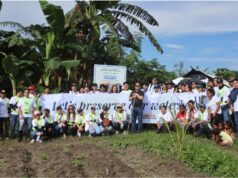“Gold is an adornment that makes you beautiful.” – World Gold Council.
Gold may not be forever like diamond but it has never lost its luster or power of attraction. Since April 2007, “gold had climbed for seven straight weeks in its longest run of weekly increases,” wrote Liza T. Agoot and Jonathan L. Mayuga in a special report published in Sunday Business Mirror.
In August 23 of this year in Singapore, gold prices hit a high record of US$1,913.50 an ounce. In the Philippines, the price of gold in the market is at P2,000 per gram.
In Baguio, where there are small mining activities, gold buyers purchase high-grade gold at P1,862 per gram.
“As demand for gold hits an all-time high, more and more cash-strapped countries, mostly developing ones, are opening their doors to gold-mining interests,” said a recent report published by London-based Panos Institute.
The report, The Lure of Gold: How Golden is the Future?, highlights the need for tight economic and environmental measures if developing countries are to benefit from gold mining.
It warns that “without new safeguards, the luster of gold may well turn out to be as illusory for developing countries as the fabled El Dorado.”
El Dorado, touted to be the Lost City of Gold, was attributed to various stories learned from the Maya after the conquest of Mexico.
The Maya spoke of their lost cities that spoke of an ancient and wealthy culture that did make extensive use of found gold, as well as jade and other precious things.
Unlike the legendary El Dorado, the Philippines is blessed with metallic minerals like iron, copper, and gold. “(Our country) is endowed with bountiful metallic and non-metallic mineral resources,” said Secretary Ramon J.P. Paje of the environment and natural resources before the Asia Mining Congress in Singapore recently.
“Currently, gold, copper, iron, chromite and nickel are the most sought after metallic commodities.”
Gold of course is the most precious of them all. In fact, the Philippines was once known as the “Isles of Gold.”
In the early 1980s, the country was the eighth-largest producer in the world. But it then slid to 14th place.
“In a bid to kick start an indebted economy and match gold exports to a 1980 peak, the government, with the help of international donors and foreign mining companies, rewrote the mining laws,” the Panos report said.
“I have never seen so many mining company chief executives as I have in the last four months,” said an official of the Department of Environment and Natural Resources (DENR) soon after the new mining laws came into effect in March 1995.
Most mining companies which applied are in the rush for Financial or Technical Assistance Agreements which “give license to explore vast areas of up to 81,000 hectares of land for a limited time.”
Critics claimed the government has abandoned mining as a national strategic industry, and sold out to foreign companies. Local companies, for instance, are restricted to exploring blocks of land up to 16,000 hectares only.
There are many other issues – including reduced taxes and the lifting of foreign ownership restrictions – that remained to be addressed. But the heart of the concerns is still the environmental woes that mining brings.
Just like the Marcopper mining disaster, considered the worst in the mining history of the Philippines.
On March 24 1996, the Marcopper’s open pit burst open and released two to three million cubic meters of mine tailing into the Boac River in Marinduque killing marine life in the 27-kilometer waterway and flooded farmlands and barangays along its banks. The cleanup cost about US$80 million.
“The Marcopper incident is a result of a big engineering mistake,” Benjamin Philip G. Romualdez, the president of Chamber of Mines, was quoted as saying in a recent forum.
“Obviously, engineering technology has improved over the years. That type of accident would never occur again.”
The Geneva-based International Labor Organization (ILO) considers mining as one of the world’s most hazardous sectors. More than 15,000 miners die each year.
“Mine workers are continually exposed to risks such as extremes of noise, vibration, heat and cold, repetitive task strain and harmful chemicals, radioactive materials, dangerous gases and dust inhalation.
Worse still, they often face combinations of many of these risks at the same time,” the ILO deplores.
Gold mining particularly has potentially heavy environmental costs, as it usually involves the use of mercury.
Whether they labor in Mount Diwalwal in Compostela Valley or in Benguet in the Cordillera, small-scale gold miners carry out a practice handed down from their forefathers. Liquid mercury is poured over crushed ore in a pan or sluice to form an amalgam.
By hand, gold miners press this through a cloth to remove the excess mercury. Crowing around, they then light it. The mercury burns off as a white vapor and is inhaled by the miners as they weigh up their shiny payroll.
In a study, it was found that of people exposed to mercury for an average of 30 months, or who lived within 500 meters of a source of mercury, almost 75 percent of those examined showed clinical symptoms of poisoning.
Another issue: deforestation. A study by the World Wild Fund for Nature showed that more than 119,000 hectares of forest cover disappear yearly. At this rate, the remaining forest cover would be depleted in 10 years.
Mining is contributing to this problem. This is particularly true among small-scale miners. The practice often lead to vegetation loss as hillsides are cleared when miners follow a vein of gold. Forest is also felled to make way for airstrips and working areas.
“I am tormented by forests,” commented Ed Coronel, who carves out his career in the Philippine mining industry. “I hold a romantic view of forests, but at the same time also a pragmatic view, that forests are a collateral damage to progress, just like other things in society.”
There are issues and there are issues. And the debates continue. In fact, there are those who want blanket prohibition for mining projects in the country.
During the first visit of the President Benigno Aquino III in Cagayan de Oro, the Civil Society Organization (CSO) in Northern Mindanao submitted a petition calling for mining’s total shut-down.
In a dialogue with thousand advocates of the multi-sectoral CSO, the president suggested a compromise for a heavy regulation of the mining industry then a total ban.
“If we remove the large-scale miners, the small scale miners would normally come in,” Aquino said, adding that retaining the large-scale mining industry would have been more logical as they are the ones being “strictly monitored and regulated” by the government.
“The government will have a hard time in dealing with illegal mining activities with the influx of small-scale miners as possible aftermath when we’re going to get rid of the large mining industry,” the president reiterated.
Should mining be totally banned in the Philippines? In his column, Fr. Emeterio Barcelon, SJ offered this timely piece:
“A valid objection is that mining operations sometimes leave the local population with little residual benefit after the mining operation. This is not true in most cases as, for example, the Baguio area mining.
If not for the mines, tourism could not have developed Baguio as it is now.
“But many of the local people are still poor. This is not because of mining but because of the sharing system. Why let the mining companies take away all the gravy and leave the community in poverty.
This is a problem of community administration and legislation, not of the extraction of minerals from the mountains. We do not need carpet baggers.
“We want responsible miners who are willing to give a fair share of the harvest with the community. We need jobs. We need wealth creation. We need mines.
We need responsible mining and as well as vigilant communities. We do not need blanket prohibitions.
“We do not need environmentalists who cry for the welfare of future generations but are blind to the problems of the jobless in the present.
We do not need foreigners who think of vast lands where they come from and can afford to waste resources. We must husband every resource that we have so we do not have to go to distant lands to find work,” the priest concluded.
The Panos report seems to agree. Mining, it said, can helped push the economic activities of a country if the government recognized mining “as a national strategic industry” aside from “developing mining policies which ensure that a fair share of the vast profits go towards local communities and sustainable development practices.”




